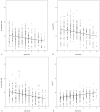Analysis of factors influencing improvement of idiopathic flatfoot
- PMID: 34397914
- PMCID: PMC8360408
- DOI: 10.1097/MD.0000000000026894
Analysis of factors influencing improvement of idiopathic flatfoot
Abstract
Idiopathic flatfoot is common in infants and children, and patients with this condition are frequently referred to pediatric orthopedic clinics. Flatfoot is a physiologic process, and that the arch of the foot elevates spontaneously in most children during the first decade of life. To achieve a consensus as the rate of spontaneous improvement of flatfoot, the present study aimed to estimate the rate of spontaneous improvement of flatfoot and to analyze correlating factors.We reviewed the records of patients examined between May 2013 and May 2019 so as to identify those factors associated with idiopathic flatfoot below 12 years of age. We included patients with who had been followed for >6 months, and those for whom ≥2 (anteroposterior and lateral) weight-bearing bilateral radiographs of the foot had been obtained. The progression rates of the anteroposterior (AP) talo-first metatarsal angle, talonavicular coverage angle, lateral talo-first metatarsal angle, and calcaneal pitch angle were adjusted by multiple factors using a linear mixed model, with sex, body mass index, and Achilles tendon contracture as the fixed effects and age and each subject as the random effects.We found that 4 of the radiographic measurements improved as patients grew older. The AP talo-first metatarsal angle, talonavicular coverage angle, and the lateral talo-first metatarsal angle decreased, while the calcaneal pitch angle increased. The AP talo-first metatarsal angle (P < .001), talonavicular coverage angle (P < .001), and lateral talo-first metatarsal angle (P < .001) improved significantly; however, the calcaneal pitch angle (P = .367) did not show any significant difference. In general, the flatfeet showed an improving trend; after analyzing the factors, no sex difference was observed (P = .117), while body mass index (P < .001) and Achilles tendon contracture (P < .001) showed a negative correlation.The study demonstrated that children's flatfeet spontaneously improved at the age of 12 years. It would be more beneficial if the clinician shows the predicted appearance of the foot at the completion of growth by calculating the radiographic indices and identifying the correlating factors in addition to explaining that flatfoot may gradually improve. This will prevent unnecessary medical expenses and the psychological adverse effects to the children caused by unnecessary treatment.
Copyright © 2021 the Author(s). Published by Wolters Kluwer Health, Inc.
Conflict of interest statement
The authors have no potential conflicts of interest to disclose.
Figures



References
-
- Giannestras NJ. Recognition and treatment of flatfeet in infancy. Clin Orthop Relat Res 1970;70:10–29. - PubMed
-
- Blitz NM, Stabile RJ, Giorgini RJ, DiDomenico LA. Flexible pediatric and adolescent pes planovalgus: conservative and surgical treatment options. Clin Podiatr Med Surg 2010;27:59–77. - PubMed
-
- Pfeiffer M, Kotz R, Ledl T, Hauser G, Sluga M. Prevalence of flat foot in preschool-aged children. Pediatrics 2006;118:634–9. - PubMed
-
- Staheli LT, Chew DE, Corbett M. The longitudinal arch. A survey of eight hundred and eighty-two feet in normal children and adults. J Bone Joint Surg Am 1987;69:426–8. - PubMed
MeSH terms
LinkOut - more resources
Full Text Sources

